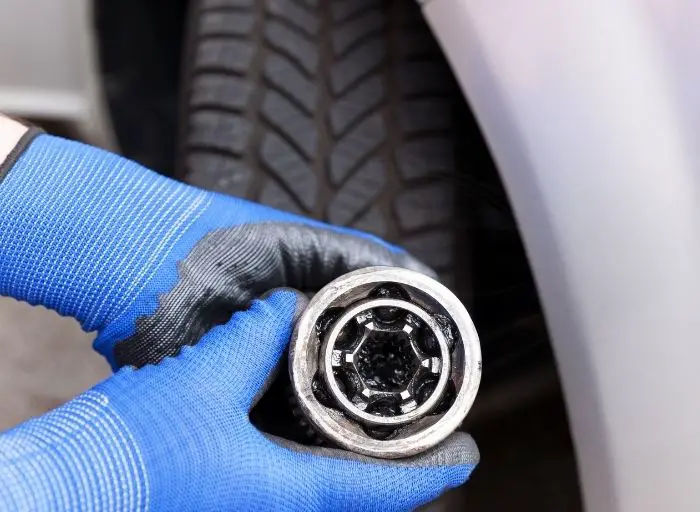
Many people pay more attention to engine bay components and less care to others when it comes to car maintenance. Aside from the numerous components placed in the engine compartment, every vehicle contains a number of other critical components, and the CV joint is one of them.
Aside from the numerous components placed in the engine compartment, every vehicle contains a number of other critical components, and the CV joint is one of them. what are the effects of CV joint failure? A failing/bad CV joint, for example, might lead to a lot of instabilities when driving.
Table of Contents
What are CV joints, exactly?
You might be wondering what CV joints are. Simply said, CV joints are complex ball-and-socket joints that connect the axles to the front wheels, allowing torque to be transferred from the transmission to the driving wheels at a constant speed. On front-wheel drive vehicles, for example, each of the two car axles has two joints, one linked to the tire and the other to the transmission.
A CV joint is greased and covered with a rubber “boot” to ensure smooth operation. Your joints are secured and power is delivered to your wheels as long as this boot remains intact. But what happens if it doesn’t work? When CV joints fail, power is no longer transferred from the motor to the tires, which is instantaneous and sometimes deadly.
What Functions Do CV Joints Serve?
It is necessary to understand the function of faulty CV joints in order to better grasp the repercussions of bad CV joints. CV joints are essentially “joints” — each drive wheel has two of them.
The transmission is connected to the axle by the inner joint, while the axle is connected to the wheel by the outer joint.
If one of these joints breaks, the other is prone to failure as well — but this may not happen right away.
The purpose of CV joints is to keep connected components together and aid in the continuous flow of power from the gearbox to the wheels.
CV joints, as you might expect, require lubrication to work smoothly; hence, if they are not adequately lubricated, friction may increase, resulting in a variety of strange symptoms or sounds when driving.
CV joints, in particular, are prone to failure, and the indicators of a damaged CV joint are listed below.
CV joint failure consequences
A faulty CV joint, like any other component of an automobile, can create many instabilities. You might notice strange vibrations, and in the worst-case situation, a faulty CV joint could ruin your car’s axle.
Here’s a real-life scenario of what can happen if your CV joint fails.
When one CV joint, say the inner one, breaks, the axle will pull out of the attached wheel, causing the axle to directly hit on the pavement, perhaps breaking the axle and bringing your automobile to a halt.
If the outer CV joint breaks, the axle will pull away from the transmission and, if you’re driving at the time, will likely hit the pavement hard.
This will also break the axle, causing your automobile to stop moving.
So, CV joint malfunction mostly impacts the axle. CV joint failure, on the other hand, can harm the driveshaft or even the associated drive wheel.
Furthermore, if a CV joint cracks, it cannot be repaired; the only option is to replace the joint with a new one.
Symptoms of a Failed CV Joint
1. Busted Boots
If the issue is simply a busted CV boot, you may be able to drive for a while before requiring repairs. The longer you travel with the boot broken, however, the more dirt and grime gets into the joint and the more oil flows out. If found early enough, the boot may usually be replaced instead of the entire joint. Mechanics will constantly search for any evidence of damage when inspecting CV boots during routine car checks.
2. Clicking, popping, and clunking
If the front wheels make a clicking, clunking, or popping sounds, especially when turning, the condition has developed to the point where the CV joint has been damaged. These can’t be fixed; they have to be replaced. For a short time, you can ride on a damaged CV joint, but there’s no way of knowing how long “safe” operation will last. There are other elements to consider, including where you drive, the quantity of dirt/dust/debris in the regions you drive, and how much moisture condenses into the joint.
3. Failure of the CV Joint
The CV joint will fail in the worst-case situation. This will effectively break the axle, leaving you with a car that will not move. If this occurs while driving, it can be dangerous, resulting in a complete loss of control. To preserve safe driving conditions, try to diagnose a faulty CV joint before this point.
It’s critical to repair your CV joint as quickly as possible if you feel it’s damaged. This is a key component that, if it fails fully, can result in a serious and dangerous situation.
Conclusion
This article clearly outlines the effects of CV joint failure; while a faulty CV joint is most likely to harm only the axle, it is possible that it will also impact other surrounding parts.
Yet, if you notice indicators of a deteriorating CV joint, you should take action right once. Most significantly, keep to a maintenance schedule and make sure that any repairs you have done on your automobile are done correctly and with original parts.
Hi there! I’m Naomi O’Colman. I’ve got years of experience working at an auto repair shop here in Texas under my belt. On top of that, ever since I was a kid I’ve been passionate about the auto industry. Since I’ve joined the team at automotivegearz.com I’ve been enthusiastically sharing my passion and insights with my readers. I’m dedicated to delivering high quality content and helping you stay up to date with the latest automotive trends and products out there!







